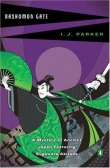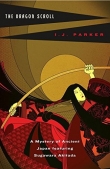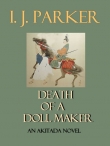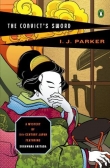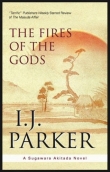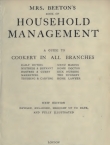
Текст книги "Compendium "
Автор книги: Ingrid J. Parker
Жанр:
Исторические детективы
сообщить о нарушении
Текущая страница: 1 (всего у книги 3 страниц)
SUGAWARA AKITADA

COMPENDIUM
 About Sugawara Akitada
About Sugawara Akitada
His noble family fallen on hard times, Sugawara Akitada works as a minor official in the Ministry of Justice in Heian Kyo, capital of Japan in the 11th century. The post is boring, but there are bills to pay, servants to maintain and a diminished estate to keep up as best he can. However, Akitada also has a sharp mind and an inquisitive nature, both of which get put to the test as he unravels murders and mysteries that carry him from the depths of the most common peasant hovels to the sacred halls of the Imperial Palace itself. Bound not only by his sense of decency and honor, but the strict codes and social structure of Ancient Japan, Akitada must step carefully while gathering clues to solve the puzzles before him. About I. J. Parker

I.J. PARKER won the Private Eye Writers of America Shamus Award for Best P.I. Short Story in 2000 for "Akitada's First Case," published in 1999. An Associate Professor of English and Foreign Languages (retired) at a Virginia university, Parker began research into11th century Japan because of a professional interest in that culture's literature. This led to the first Akitada short story, "Instruments of Murder," published in Alfred Hitchcock's Mystery Magazine in October of 1997. Although Parker's multi-lingual background includes a little Japanese, research is done using translations and the help of scholars specializing in the period. She has no agent at the moment.
 About Heian Japan
About Heian Japan
The Heian Period in the history of Japan is often referred to as “the golden age.” It lasted from the 9th through the 12th centuries and preceded the medieval era of shoguns and samurai. The Heian Age was characterized by relative peace and stability and a central government in the capital, Heian-kyo, by an emperor and the court aristocracy. It is the historical background for both the Akitada mystery series (11th century) and the novel The Hollow Reed (12th century).

Nobleman's House
 Sugawara no Akitada
Sugawara no Akitada
Sugawara no Akitada (in Japan, the family name comes before the given name, and the "no" is an obsolete link in noble names) is thought to have been born in 989 A.D. into a family of scholar officials (for his precise parentage, see THE HELL SCREEN). His childhood and early teens were spent in the family mansion in Heian Kyo (the capital of Japan at the time and modern Kyoto) as the only son of a minor functionary in the imperial administration.
Following in his father's footsteps, he attended the imperial university (for details about university life, see RASHOMON GATE) just south of the Daidairi, or Greater Palace, where his father and hundreds of other nobles worked in the offices of various ministries and bureaus.

Akitada pursued a legal curriculum and placed first in the final examinations. This guaranteed him a position in the government service, and he started his career as a very junior clerk in the Ministry of Law. By this time, his father had died, leaving him the only support for a demanding mother and two younger sisters, a responsibility he will have increasing difficulty with by getting involved in criminal cases that are none of his business and lead to reprimands and even dismissals (see "Akitada's First Case"). The People of Heian Japan:
In Akitada's time only two classes – nobles and commoners – existed, but there was also an underclass of "non-persons," the slaves and outcastes. Akitada was born one of the "good people," though he clings rather desperately to the bottom rung of that ladder. Perhaps it is this fact which gives him a greater closeness to and understanding for the less fortunate and causes him to keep breaking rigid social rules to associate with them.
Carriages at the Gate Servants

Those above him in rank are far more powerful nobles, in particular members of the Fujiwara clan, one branch of which (the sekkanke) furnished the chancellors and senior ministers, most of the imperial consorts, and filled many other upper level positions in the central and provincial administrations.

Those below him are peasants, merchants, artisans, and soldiers. Of these, the peasants were the poorest but most highly respected because they fed the nation. The merchants and artisans lived in the cities and sometimes became prosperous, especially if they dealt wholesale in rice, silk, or sake, or if they practiced a valued skill, for example sword making.
Among the slaves and outcastes were entertainers, laborers, and workers in despised trades (for example, butchery, leather-working, or handling the dead. This class originated probably from early prisoners of war, condemned criminals, and natives of the northern territories; it was perpetuated through birth and practice into the present day. Visit to a Shrine Beside the lay population, there was also the clergy which was essentially classless, but had its own ranks. There were Shinto priests and priestesses and Buddhist monks and nuns. Akitada, somewhat uncharacteristically for a nobleman of his period, dislikes and distrusts Buddhism and prefers the native Shinto beliefs. Monks


Since both faiths played an enormous role in the lives of high and low, Buddhist and Shinto clergy were common and visible in society. Shinto priests were attached to Shinto shrines but participated in many public rituals. They could marry, and their functions were often hereditary. Buddhists clergy, who came from all classes, were supposed to be celibate.
Because many noble persons and emperors gave up the “world” in old age or because of serious illness or, in the case of women, because their husbands died, the highest-ranking Buddhist clergy came from the ruling class. Apart from those who lived in monasteries, Buddhist clergy also served as village priests or wandered the roads, begging and preaching. Towards the end of the Heian age, large monasteries became increasingly warlike, maintained armies of warrior monks, attacked rival institutions, and took sides in secular politics. Akitada encounters warrior monks in THE DRAGON SCROLL. The Ancient Capital

During Akitada’s time, the capital of Japan was Heian Kyo, the modern Kyoto. Founded in 794, it remained the capital until the 13th century and the seat of the emperor until 1869.
fromIvanMorris,ThePillowbookofSeiShonagon In plan, the capital was very similar to the great Chinese capitals like Chang-An, and followed the Chinese belief that cities needed three mountains nearby – to the north, west, and south. They also needed rivers to the west and east, and a large pond to the south. The reasons for these geographic features were based on fears of evil influences which could approach a city from all sides. Beyond these considerations, the layout of Heian Kyo followed strict rules of order. It was to be rectangular, bisected by a major north-south avenue, intersected at precise distances by north-south and east-west roads forming a grid pattern, and the seat of government had to occupy the northernmost center, forming a walled rectangular imperial city within the capital. Such orderliness of planning pervaded much of the political thought of the time, and Akitada is thoroughly versed in the teachings of Confucian order and harmony. He strongly disapproves of disorder.
In Heian-kyo, the imperial residence (dairi) was part of the greater imperial city (daidairi) which encompassed all the government buildings and offices. It was walled and gated, as was the larger enclosure, the various ministries, and many of the noble mansions that surrounded the imperial city

Shishinden, part of imperial residence
The city itself, however, was merely enclosed by a moat and ramparts. Its main southern gate, Rashomon, means “rampart gate.” From the huge, two-storied Rashomon, Suzaku Avenue (80 yards wide, with a central canal and lined with willows) led north to Suzakumon, the gate into the imperial city. To the right and left of Rashomon stood two Buddhist temples, To-ji and Sai-ji, with five-storied pagodas. About halfway to the palace, to the east and west, two enormous market places served the people of Heian Kyo.
Closer to the palace were the east and west administrations of the capital, the university, and a large park. The quarters on either side of the imperial city were originally reserved for the ranking nobles, but the western quarter declined early.
Akitada works inside the imperial city in the Ministry of Justice, more than likely a large hall with wings that stood inside its own walled and gated courtyard. His residence is in the north-eastern quarter, a typical nobleman’s house in a walled enclosure, with separate pavilions, covered galleries, and outbuildings, such as stable and kitchen. Though large and in a good neighborhood, it is in constant poor repair and sadly under-staffed because the family has fallen on ill times.
In spite of the careful planning along the lines of Chinese ideals, the real world and the character of the Japanese people soon asserted themselves in Heian Kyo. In the precise plan of the capital all sorts of charming irregularities appeared. Small rivers and canals crossed the city in odd places, bisecting quarters and avenues as they were diverted into manmade landscape gardens and ponds. 
Capital from the East
People also resisted an orderly building program and preferred to settle on land east of the Kamo River, which led to the decline of the western half of the city. Great nobles, who built enormous estates surrounded by landscape gardens, instantly attracted clusters of more modest buildings around their walls. Parts of the city became rural, with vegetable plots, chickens, and life stock. Less charmingly, frequent fires destroyed the wooden buildings, creating empty land that was settled by squatters. Crime flourished in these quarters and spread even into the imperial enclosure. Great buildings collapsed in storms and were not always rebuilt. This eventually even eliminated the famous southern gate, Rashomon. The emperors themselves moved constantly from the imperial residence to various noble houses because of fires in the palace. Storms, fires, and epidemics periodically decimated the population. Population figures for Heian Kyo vary wildly between 100,000 and 200,000. Life in the city was characterized by uncertainty and flux.
The Novel s
TheDragonScroll
The Dragon Scroll is the first novel in the Akitada series. Akitada is twenty-five years old, an impoverished nobleman and earnest government official on his first major assignment. His whole future career rides on this performance.
He has been sent to Kazusa province in Eastern Japan to discover the whereabouts of missing taxes before the provincial governor can leave his office and return to court. Eager and naïve about political intrigues, Akitada blunders instantly into a dangerous conspiracy when the suspicious death of the previous governor attracts his attention. This signals a sequence of shocking and bloody violence in the provincial capital. As two beautiful women play on his sympathies, Akitada is distracted from a duty which becomes less and less palatable. In the end, both his official and his private persona are tested.
Among the characters, new readers will meet two regulars, the elderly family servant, Seimei, and the impudent womanizer Tora. The meeting between Akitada and Tora in this novel begins the strong bond between master and servant that characterizes the later novels.
The other characters represent a cross section of Japanese society in the eleventh century; they include noblemen-scholars, Buddhist clerics, minor officials in the provincial administration, soldiers, artisans, wrestlers, peddlers, prostitutes, gangs, and one very unusual young woman who matches her fighting skills against any man.
Rashomon Gate
Sugawara Akitada serves as a minor official in the Ministry of Justice. Though born into a noble family, his family's estate is sadly diminished, forcing Akitada to toil fruitlessly at an unsuccessful career. So when an old friend, Professor Hirata, calls upon Akitada for help, he welcomes the opportunity to escape from his dull assignments.
One of the professor's colleagues is being blackmailed, and to save the Imperial University from scandal, Hirata asks his former pupil to investigate the situation. After taking a leave of absence from the Ministry, Akitada joins the staff of the university as a visiting lecturer, and finds himself drawn into a web of gossip and petty rivalries.
Nearly everyone he encounters is suspect, but Akitada's attentions are soon sidetracked by the murder of a young woman, and the mysterious disappearance of a student's grandfather. The emperor himself has declared the case a miracle, but Lord Minamoto refuses to believe the pious tale of his grandfather's transfiguration. Though there is no evidence of foul play, it is clear to Akitada that Minamoto's life has also become endangered as he plunges into a dangerous investigation of conspiracy among high-ranking nobles.
Black Arrow
In this, the third of the novels, Akitada begins his official assignment as provisional governor in one of the nation’s northernmost provinces. Since the government does not provide him with adequate funds, he and his pregnant young wife are accompanied only by his elderly secretary and three assistants, a pitiful force to contend with a lawless and hostile population, a treacherous warlord, empty granaries, and understaffed and dilapidated headquarters. The situation becomes more ominous when he learns that recent governors have either been killed or have fled for their lives. Although the heavy snows of winter are about to cut them off from outside help, Akitada faces these odds, risking their lives as he tries to bring the province back under imperial control and to clear three innocent men who await execution in his jail.
Soon the situation deteriorates. His tribunal staff rebels, one of his assistants is nearly killed, an increase in murder is laid at his door, and the warlord mounts a military attack on the tribunal. In the end, the peaceable Akitada must take up arms and go to war against his enemies.
Island of the Exiles
The fourth adventure of Sugawara Akitada begins when two senior officials of the court order him to nearby Sado Island to investigate the death of an imperial prince in exile. Remote Sado Island is noteworthy only for its penal colony and gold mine. When its most illustrious prisoner, Prince Okisada, is murdered and the governor’s son is arrested, the court sends Akitada from neighboring Echigo to investigate.
In a covert mission as a prisoner, Akitada clears the accused and discovers a deadly conspiracy but at the cost of falling into the hands of brutal guards and disappearing into the bowels of the earth. Though there seems no hope, Tora, his loyal friend and assistant, begins his own dangerous search of the island. Only endurance and determination ultimately free Akitada to join with Tora and complete his mission successfully and with surprising results.
The Hell Screen
Government official turned sleuth Akitada Sugawara, on his way home to attend the sickbed of his bitter, aging mother, is spending the night at a monastery when he finds himself drawn to a brilliantly illustrated screen depicting the horrors of hell. His brief stay is complicated by the murder of a beautiful young woman. Personal and professional interests begin to merge as Akitada becomes ensnared in a tangled web of deceit and malevolence that will, in the end, strike very close to home.
The Convict’s Sword
“Some days he felt the shame of that half-forgotten promise almost like a physical blow, or a sword thrust into his belly, like that agonizing wound which had taken Haseo’s life.” Haunted by his vow to find the man responsible for the death of his friend Haseo, Lord Sugawara Akitada, senior secretary in the Ministry of Justice, temporarily abandons his post and sets out to fulfill his promise. But Haseo, condemned to die in exile for a crime he did not commit, left only his sword behind as a clue to his past. At the same time, Akitada’s retainer, Tora, is investigating the violent death of a blind street singer amid a smallpox outbreak that threatens the entire city. Weaving together history, drama, mystery, romance, and adventure, The Convict’s Sword is a story of passion and redemption that brings eleventh-century Japan vividly to life.
The Masuda Affair
Eleventh-centuryJapan: Government official Sugawara Akitada is on his way home to the capital of Heian-Kyo when he finds a small mute boy on a deserted road. Akitada, still grieving for his own small son, opens his arms to the child. The search for the boy’s parents uncovers a harrowing story of love, murder and abandonment, distracting Akitada from his own troubles, but putting his career and reputation at risk. Meanwhile, Akitada’s faithful servant Tora has troubles of his own: he has lost his new bride to a powerful man who pursues beautiful women and will stop at nothing to possess them. The trails of these two seemingly unrelated cases lead Akitada and Tora to the entertainers and prostitutes of the amusement quarter, and murder follows in their footsteps .
The Fires of the Gods
Eleventh-centuryJapan: Eleventh-century Japan. The capital of Heian-Kyo is plagued by unexplained fires, and panic is threatening to break out, but government official Sugawara Akitada has his own problems to worry about. His ailing wife is expecting a child, and he loses his job to a political appointee. When he tries to confront the nobleman who is responsible for his dismissal, however, he ends up suspected of his murder.
With no income and a growing family to support, Akitada desperately plunges into the investigation of this crime, aided by his faithful servant Tora, inadvertently placing not only his own life, but also the lives of his wife and child, in grave danger .
Death on an Autumn River
In this ninth novel in the Akitada series, Akitada takes a river journey to Naniwa to unmask officials selling information to pirates. Accompanied by a very young and naïve clerk, he witnesses the recovery of the body of a drowned child prostitute. Her image follows him even as his own problems and disasters multiply in Naniwa. Someone is sabotaging his investigation. His young clerk disappears. Akitada is attacked by two thugs, and armed men brutalize his family in the capital. When Tora joins his master, they both fall into the hands of the pirates and must fight a bloody battle to escape. Even after his official assignment is completed, it is the tragic story of the dead girl that will haunt Akitada most.
The Emperor's Woman
She was intended to be the emperor’s concubine, but she died at the bottom of a cliff near Prince Atsuhira’s private villa. The palace covered up the scandal. Months later, Akitada is drawn into the case when his best friend is accused of plotting against the emperor. Atsuhira, his alleged co-conspirator, refuses to defend himself. The mystery of the lady’s death unravels slowly, bringing danger to Akitada, whose household is already threatened by an ill-fated relationship between Genba and a prostitute which leads to his arrest for the brothel keeper’s murder.
Surrounded by a cast ranging from outcasts and assassins to noblewomen serving in the inner apartments of the imperial palace, Akitada not only delves into murky palace secrets, but his efforts to solve two murders require him to examine the many roles played by women in his society.
The Short Stories Akitada and the Way of Justice
NEW: A collection of eleven Akitada stories, arranged chronologically for his career, is now available as a Kindle Exclusive. Eleven stories, arranged chronologically, illustrate Akitada’s career. The cases are diverse, with clues ranging from moon cakes and Chinese lutes to feral cats and incense competitions. They have previously appeared in Alfred Hitchcock's Mystery magazine, and the first story won the Shamus Award.
